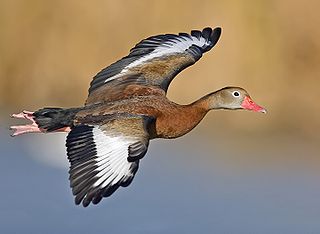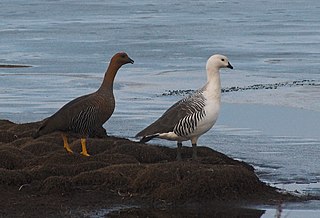
A goose is a bird of any of several waterfowl species in the family Anatidae. This group comprises the genera Anser and Branta. Some other birds, mostly related to the shelducks, have "goose" as part of their names. More distantly related members of the family Anatidae are swans, most of which are larger than true geese, and ducks, which are smaller.

The greylag goose or graylag goose is a species of large goose in the waterfowl family Anatidae and the type species of the genus Anser. It has mottled and barred grey and white plumage and an orange beak and pink legs. A large bird, it measures between 74 and 91 centimetres in length, with an average weight of 3.3 kilograms. Its distribution is widespread, with birds from the north of its range in Europe and Asia migrating southwards to spend the winter in warmer places. It is the ancestor of most breeds of domestic goose, having been domesticated at least as early as 1360 BCE. The genus name is from anser, the Latin for "goose".

The greater white-fronted goose is a species of goose related to the smaller lesser white-fronted goose. It is named for the patch of white feathers bordering the base of its bill, in fact albifrons comes from the Latin albus "white" and frons "forehead". In Europe it has been known as the white-fronted goose; in North America it is known as the greater white-fronted goose, and this name is also increasingly adopted internationally. Even more distinctive are the salt-and-pepper markings on the breast of adult birds, which is why the goose is colloquially called the "specklebelly" in North America.

The snow goose is a species of goose native to North America. Both white and dark morphs exist, the latter often known as blue goose. Its name derives from the typically white plumage. The species was previously placed in the genus Chen, but is now typically included in the "gray goose" genus Anser.

The Anatidae are the biological family of water birds that includes ducks, geese, and swans. The family has a cosmopolitan distribution, occurring on all the world's continents except Antarctica. These birds are adapted for swimming, floating on the water surface, and in some cases diving in at least shallow water. The family contains around 174 species in 43 genera.

The Canada goose, sometimes called Canadian goose, is a large wild goose with a black head and neck, white cheeks, white under its chin, and a brown body. It is native to the arctic and temperate regions of North America, and it is occasionally found during migration across the Atlantic in northern Europe. It has been introduced to France, the United Kingdom, Ireland, Finland, Sweden, Denmark, New Zealand, Japan, Chile, Argentina, and the Falkland Islands. Like most geese, the Canada goose is primarily herbivorous and normally migratory; often found on or close to fresh water, the Canada goose is also common in brackish marshes, estuaries, and lagoons.

The emperor goose, also known as the beach goose or the painted goose, is a waterfowl species in the family Anatidae, which contains the ducks, geese, and swans. In the winter, the emperor goose lives in mudflats and coasts in Alaska and occasionally Canada and the contiguous United States. In the summer, it migrates northerly several hundred miles to arctic and sub-arctic climates, where older individuals breed monogamously. Listed as near threatened by the International Union for Conservation of Nature, the species' population is declining due to threats such as pollution, hunting, and climate change.

The magpie goose is the sole living representative species of the family Anseranatidae. This common waterbird is found in northern Australia and southern New Guinea. As the species is prone to wandering, especially when not breeding, it is sometimes recorded outside its core range. The species was once also widespread in southern Australia but disappeared from there largely due to the drainage of the wetlands where the birds once bred. Due to their importance to Aboriginal people as a seasonal food source, as subjects of recreational hunting, and as a tourist attraction, their expansive and stable presence in northern Australia has been "ensured [by] protective management".

The black geese of the genus Branta are waterfowl belonging to the true geese and swans subfamily Anserinae. They occur in the northern coastal regions of the Palearctic and all over North America, migrating to more southernly coasts in winter, and as resident birds in the Hawaiian Islands. Alone in the Southern Hemisphere, a self-sustaining feral population derived from introduced Canada geese is also found in New Zealand.

The spur-winged goose is a large, Sub-Saharan African waterbird in the family Anatidae, which includes geese and shelducks. However, over millennia, P. gambensis developed unique environmental adaptations, which resulted in the evolution of several anatomical features that are not shared with other anatids; thus, the species has been classified one step further into its own subfamily, the Plectropterinae.

The whistling ducks or tree ducks are a subfamily, Dendrocygninae, of the duck, goose and swan family of birds, Anatidae. In other taxonomic schemes, they are considered a separate family, Dendrocygnidae. Some taxonomists list only one genus, Dendrocygna, which contains eight living species, and one undescribed extinct species from Aitutaki of the Cook Islands, but other taxonomists also list the white-backed duck under the subfamily.

The spotted whistling duck is a member of the duck family Anatidae. It is also referred to as the "spotted tree duck". This duck can be found in Indonesia, New Guinea, Australia and the Philippines. Spotted ducks are also held in captive populations.

The upland goose or Magellan goose is a sheldgoose of the shelduck-sheldgoose subfamily of the Anatidae, the biological family that includes the ducks and most duck-like waterfowl such as the geese and swans. Sheldgeese resemble true geese and display similar habits, yet they are more closely related to shelducks and ducks. The two recognized subspecies of upland goose are the continental picta subspecies and the insular (island) leucoptera subspecies.
Geese are waterfowl of the family Anatidae.

Anser is a waterfowl genus that includes the grey geese and the white geese. It belongs to the true goose and swan rank of Anserinae under the family of Anatidae. The genus has a Holarctic distribution, with at least one species breeding in any open, wet habitats in the subarctic and cool temperate regions of the Northern Hemisphere in summer. Some also breed further south, reaching into warm temperate regions. They mostly migrate south in winter, typically to regions in the temperate zone between the January 0 °C (32 °F) and 5 °C (41 °F) isotherms.

Geese are an important motif in Chinese poetry. Examples of goose imagery have an important place in Chinese poetry ranging from the Shijing and the Chu Ci poets through the poets of Han poetry and later poets of Tang poetry such as Li Bai, Wang Wei, Du Fu, and the Xiaoxiang poetry, especially in the poetry of the Song dynastic era. Various poetic concepts could be communicated by the inclusion of the imagery of geese in a poem, and the understanding of allusions to a goose or geese can help provide key insights into the poems of Classical Chinese poetry. Chinese sources typically distinguish between two types of geese, the domestic goose, and the wild goose: of the two, the wild goose is the more important for poetry, whether as significant of migratory seasonal change, or as "bearing a message of love from afar", by persons separated by a great distance, or as the "lone goose", bereft of both mate and flock.

In ethology and cognitive ethology, the hawk/goose effect refers to a behavior observed in some young birds when another bird flies above them: if the flying bird is a goose, the young birds show no reaction, but if the flying bird is a hawk, the young birds either become more agitated or cower to reduce the danger. The observation that short-necked and long-tailed birds flying overhead caused alarm was noted by Oskar Heinroth. Friedrich Goethe conducted experiments with silhouettes to examine alarm reactions in 1937 and a more systematic study was conducted in the same year by Konrad Lorenz and Nikolaas Tinbergen which is considered one of the classic experiments of ethology.
















